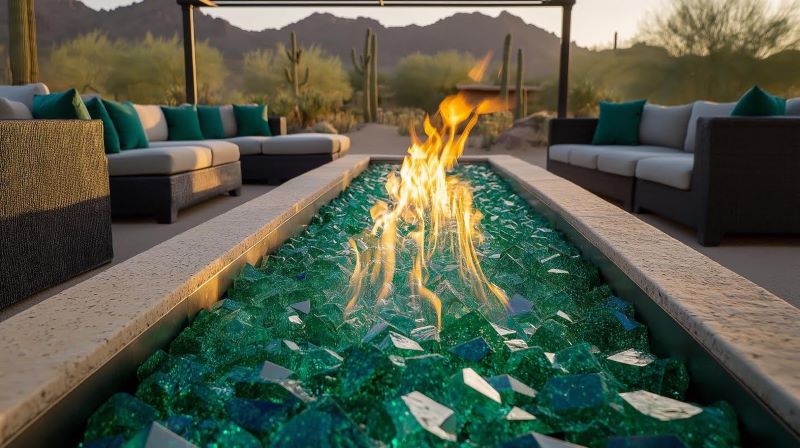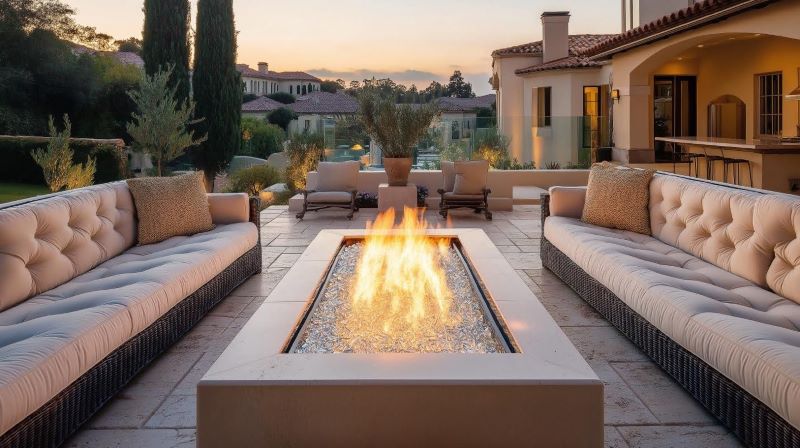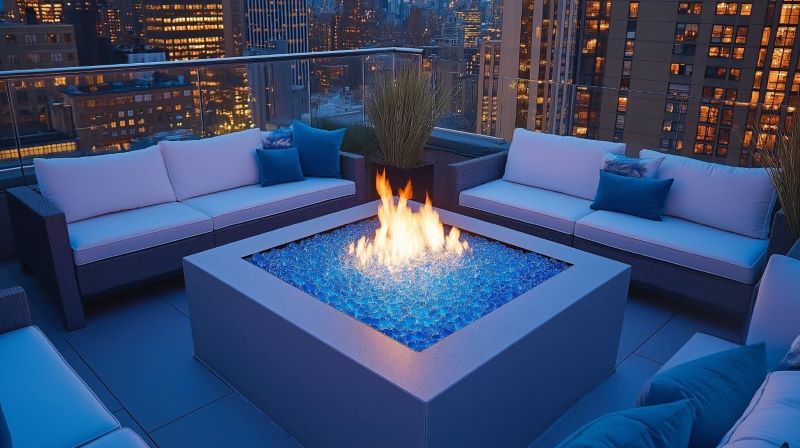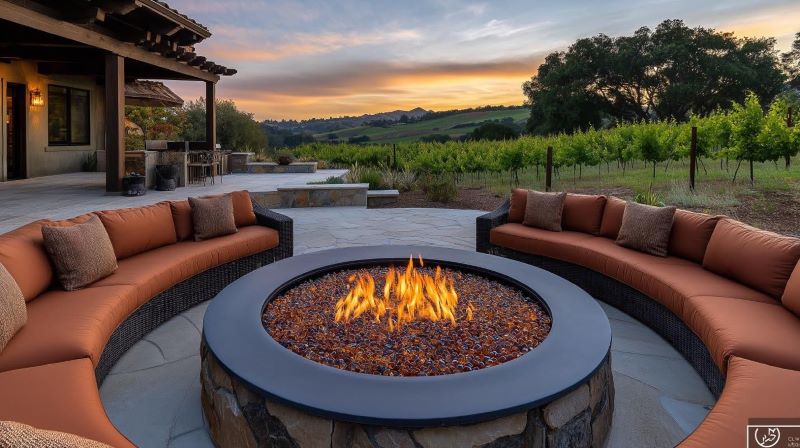Decorative glass pieces for fire pits are great for taking your patio design to the next level. And there’s definitely some right ways to do it, and some wrong ways…
Let me tell you about the time I almost turned my backyard fire pit into what looked like a science experiment gone wrong. Three summers ago, I thought I was being clever by tossing some random colored glass pieces I found at a craft store into my gas fire pit. The result? A melted, smoky mess that had my neighbors questioning my sanity and me frantically googling “how to clean melted glass from fire burner” at 11 PM. That expensive mistake taught me everything I never knew I needed to learn about fire glass – the hard way.
If you’re considering adding some sparkle and sophistication to your fire pit or fireplace, you’ve probably stumbled across fire glass during your research. This isn’t just any old decorative glass you can grab from the clearance bin at your local craft store. Fire glass is a specially designed, tempered glass product that transforms ordinary gas fire features into stunning focal points that’ll have your guests asking where you got such a gorgeous setup.
The beauty of fire glass lies not just in its aesthetic appeal, but in its practical benefits too. Unlike traditional lava rock or ceramic logs, quality fire glass pieces don’t absorb moisture, resist fading, and create a cleaner burning environment for your outdoor gatherings. They reflect light, creating a beautiful visual effect that makes flames appear more dynamic and engaging.
My Essential Highlights for Fire Glass Success
- Decorative glass pieces enhance the aesthetic of fire pits while providing practical benefits like smoke reduction and easy maintenance
- Over 75% of homeowners prefer decorative glass over traditional fire pit materials, with sales increasing 34.7% in recent years
- Tempered glass is commonly used for safety and durability, available in various colors and sizes to match any decor
- Proper installation techniques and safety considerations make the difference between stunning results and costly mistakes
- Smart color choices and mixing strategies can create custom looks that complement your outdoor design aesthetic
Types of Decorative Glass Pieces for Modern Fire Features
When I started researching fire glass after my craft store disaster, I discovered there’s actually a whole science behind these sparkling little gems. Fire glass pieces come in several distinct types, each offering unique visual characteristics and flame interactions.
Classic Fire Glass Chunks
The most traditional option, classic fire glass consists of flat-sided pieces that create clean lines and sharp reflections. These chunks typically measure between 1/4 inch to 3/4 inch and work well in most standard fire pit configurations. From my perspective, classic chunks offer the most versatility for beginners because they’re forgiving if you accidentally over-fill your burner area.
Fire Beads and Rounded Options
Fire beads sport a contemporary rounded shape that creates softer flame patterns. I’m convinced that fire beads work particularly well in modern outdoor settings where you want a more fluid, organic flame appearance. The rounded surfaces allow gas to flow more freely, which can result in taller, more dynamic flames.
Fire Diamonds and Angular Shapes
For those seeking an ultra-modern aesthetic, fire diamonds feature sharp, geometric cuts that create dramatic light refraction effects. These angular pieces tend to stack differently than traditional chunks, creating interesting texture variations within your fire feature.
Specialty Shapes and Designer Options
The fire glass market has exploded with specialty shapes including cubes, dots, and even custom-molded designs. While these premium options cost more, they can create truly unique visual effects that set your fire feature apart from the standard installations you see everywhere.
Benefits of Using Glass in Fire Pits Over Traditional Materials
After years of working with different fire pit media at Patio Productions, I can tell you that glass offers advantages that traditional materials simply can’t match. Glass pieces do not emit smoke or soot like traditional fuels, which means your outdoor gatherings won’t leave everyone smelling like a campfire.
Heat Efficiency and Distribution
Fire glass excels at heat retention and even distribution. Unlike lava rock, which can absorb moisture and crack during freeze-thaw cycles, tempered glass maintains its integrity through temperature extremes. The glass pieces actually help radiate heat more efficiently, keeping your space comfortable longer after you’ve turned down the gas flow.
Maintenance Advantages
Traditional fire pit materials like ceramic logs or lava rock eventually break down, fade, or accumulate residue that affects performance. Quality fire glass maintains its appearance for years with minimal care. When cleaning becomes necessary, a simple rinse with warm water and mild soap restores the original sparkle.
Environmental Considerations
Many fire glass products are manufactured from recycled materials, making them an environmentally conscious choice. Since glass doesn’t burn or decompose, you’re not releasing particles into the air like you would with traditional wood or coal burning.
Sizing and Choosing the Right Glass for Your Fire Feature
Getting the sizing right can make or break your fire glass installation. I learned this lesson when I initially purchased glass pieces that were too large for my burner, creating uneven flame patterns and reduced heat output.
Understanding Glass Measurements
Fire glass sizing refers to the longest dimension of each piece, not the thickness. Quarter-inch glass works well in smaller fire features and tabletop units, while half-inch to three-quarter-inch pieces suit larger outdoor fire pits. The average decorative glass piece weighs approximately 6.4 pounds, which affects how much product you’ll need for adequate coverage.
Coverage Calculations
Most manufacturers recommend 1-2 inches of glass depth over your burner for optimal performance. Too little glass exposes the burner mechanism, while too much can restrict gas flow and reduce flame height. A helpful rule involves calculating your fire pit’s surface area and multiplying by the desired depth to determine the volume of glass needed.
Mixing Size Options
Combining different glass sizes creates visual depth and texture variation. Starting with a base layer of larger pieces and topping with smaller glass can create interesting layered effects while maintaining proper gas flow through the media.
Color Options for Fire Pit Glass That Transform Outdoor Spaces
The color selection process often overwhelms first-time buyers, but understanding how different hues interact with flames and surroundings simplifies decision-making significantly.
Classic and Neutral Tones
Clear and white fire glass offers timeless appeal that complements any outdoor design scheme. These neutral options reflect flames beautifully while maintaining versatility through seasonal decor changes. Approximately 82% of fire pit enthusiasts report that colored glass enhances their outdoor aesthetics, but neutrals provide the most long-term flexibility.
Bold and Dramatic Colors
Deep blues, emerald greens, and rich burgundy create striking focal points that make definitive design statements. These saturated colors work particularly well in contemporary settings where the fire pit serves as a primary visual anchor for the space.
Earth Tones and Natural Hues
Bronze, amber, and copper tones blend seamlessly with natural landscapes and complement traditional outdoor furniture styles. These warmer colors create cozy, inviting atmospheres that encourage longer outdoor gatherings.
Specialty and Designer Colors
Premium manufacturers offer unique color options like sky blue, cobalt, and even metallic finishes that create one-of-a-kind installations. While these specialty colors command higher prices, they can justify the investment in high-end outdoor living spaces.
Mixing and Matching Glass Types for Custom Looks
Creating custom glass combinations requires understanding how different types interact visually and functionally. I’ve seen beautiful installations ruined by poor mixing decisions, so taking time to plan your combination pays dividends.
Two-Color Combinations
Pairing complementary colors creates dynamic visual interest without overwhelming the design. Popular combinations include clear with bronze for subtle warmth, or blue with white for coastal-inspired themes. Starting with a 60-40 or 70-30 ratio prevents either color from dominating.
Multi-Color Blending
Three-color combinations require more careful planning but can create stunning gradient effects. Success depends on choosing colors that share similar intensity levels and work harmoniously together rather than competing for attention.
Texture Mixing Strategies
Combining different glass shapes adds texture variation that catches light differently throughout the flame cycle. Mixing classic chunks with fire beads, for example, creates visual depth while maintaining proper gas flow characteristics.
Installation Tips for Decorative Glass Success
Proper installation determines whether your fire glass investment delivers the stunning results you’re expecting or becomes another expensive learning experience.
Base Preparation
Start with a clean burner free of debris, old media, or moisture. Many installations benefit from a thin base layer of lava rock beneath the glass, which improves drainage and reduces the total volume of glass required.
Layering Techniques
Build your glass layer gradually, checking gas flow and flame patterns as you add material. The goal involves achieving even coverage without overfilling, which can smother flames or create uneven burning patterns.
Safety Clearances
Maintain proper clearances between glass and any combustible materials. Follow manufacturer specifications for minimum distances, and remember that glass can retain heat long after flames are extinguished.
Maintaining and Cleaning Fire Pit Glass for Longevity
Regular maintenance keeps your fire glass looking pristine and performing optimally. The cleaning process is straightforward, but timing and technique matter for best results.
Routine Maintenance
Monthly visual inspections help identify any issues before they affect performance. Look for discoloration, debris accumulation, or pieces that may have shifted and created uneven coverage.
Deep Cleaning Process
Annual deep cleaning involves removing all glass pieces and washing them in warm, soapy water. A 50-50 vinegar and water solution works particularly well for removing mineral deposits or stubborn residue. Always ensure glass pieces are completely dry before reinstalling to prevent popping sounds during operation.
Troubleshooting Common Issues
Glass that pops or makes crackling sounds usually indicates trapped moisture. Discoloration might result from poor quality glass or contamination from foreign materials. Address these issues promptly to prevent damage to your fire feature.
Safety Considerations for Fire Glass Applications
Safety always takes priority over aesthetics when working with fire features. Understanding potential hazards and prevention strategies protects both people and property.
Temperature Management
Fire glass becomes extremely hot during operation and retains heat long after flames are extinguished. Always allow complete cooling before handling, and educate family members about these safety considerations.
Gas Flow Requirements
Proper glass depth and distribution ensure adequate gas flow for safe, efficient operation. Restricted gas flow can create dangerous conditions or poor performance that affects the entire fire feature.
Installation Standards
Professional installation ensures compliance with local fire codes and manufacturer specifications. Gas connections, clearances, and safety features require proper setup for safe operation.
Where to Purchase Quality Fire Pit Glass Products
Finding reliable sources for quality fire glass prevents the disappointments that come with inferior products. On average, a single bag of decorative fire pit glass costs around $45, containing about 20 pounds of material, so choosing reputable suppliers protects your investment.
Manufacturer Direct Options
Purchasing directly from manufacturers often provides the best selection and technical support. Many offer custom color matching services and bulk pricing for larger projects.
Specialty Retailers
Fire feature specialists understand the technical requirements and can provide guidance on proper sizing, coverage calculations, and installation techniques. Their expertise often justifies slightly higher prices.
Online Marketplace Considerations
While online marketplaces offer competitive pricing, verify that products meet safety standards and come with proper documentation. Read reviews carefully and check return policies before committing to larger purchases.
Final Thoughts on Fire Glass Selection
Selecting the right fire glass transforms ordinary gas fire features into stunning focal points that enhance any outdoor living space. Success depends on understanding the interaction between glass type, color, sizing, and installation technique rather than simply choosing the prettiest option you can find.
Remember that quality fire glass represents a long-term investment in your outdoor living space. While premium products cost more initially, their durability and performance characteristics provide better value over time compared to budget alternatives that may discolor, crack, or require frequent replacement.
Take time to plan your installation carefully, considering how the glass will interact with your existing design elements and intended use patterns. Whether you choose a single bold color or create a custom blend, proper selection and installation will deliver years of beautiful, safe operation that makes your fire feature the envy of the neighborhood.




